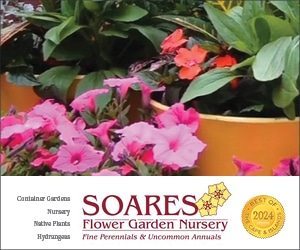
“The way it used to was”
Cape Cod Life / August 2020 / Art & Entertainment, History, People & Businesses
Writer: Charlotte Russell
“The way it used to was”

Cape Cod Life / August 2020 / Art & Entertainment, History, People & Businesses
Writer: Charlotte Russell

Restaurateur and art collector Anton ‘Napi’ Van Dereck told the story of Provincetown through art and food
This summer in Provincetown is bittersweet. Beloved legend Anton ‘Napi’ Van Dereck passed away on Christmas day, 2019 at 87. He leaves behind a legacy as a restaurateur, community supporter, and art collector with close to 300 world-class pieces. Dereck was better known by his nickname, Napi, given to him by his grandfather who, while his mother was pregnant, would say that what the world needed was another Napoleon. “He would pontificate about anything. He was very opinionated, but it was not offensive; it was nostalgic. His love for Provincetown came through in what he told you, but also in this collection he built over decades,” says Provincetown Art Association and Museum (PAAM) Director Christine McCarthy.
Napi spent most of his life in Provincetown around artists and creatives with his mother and his father, an early modernist artist and professor of art. A favorite photograph hanging in Napi’s office is of himself as a young child, naked, watching his father paint, with rapt attention. His love of looking at paintings continued throughout his life as a restaurant owner and an art collector.
The story of Napi’s Restaurant is just as iconic as Napi himself. Owned with his wife, Helen, Napi’s Restaurant is a unique dining experience and the restaurant itself is a piece of art. Napi and Helen, with the help of master craftsman Bob Baker and friends, transformed a string of tin auto garages into a restaurant using reclaimed and salvaged materials. The interior is furnished with antiques from the couples’ former antique shop, and locally sourced works of art. One block off of Commercial Street, Napi’s Restaurant serves up Cape Cod fare with an international twist year-round. This art-filled setting is a place that represents the town and its creative history for everyone to enjoy.
The concept for the restaurant dubbed “the most unusual restaurant in Provincetown,” grew out of a Wednesday night dinner series Napi and Helen hosted at their cottage. At this weekly dinner, musicians, artists and creatives would gather for a communal meal, jam session, and party. The mandolin was his instrument of choice. Through the restaurant, Napi continued this tradition of creating a community around food, music, and art. Music played by professional musicians and friends fills the air most nights. The inclusion of culinary influences from around the world is due to Helen, the original chef at Napi’s Restaurant. Napi, who loved to expound on any subject, was an ever-present character at the restaurant, ready to tell visitors a story about the area. “You could set your watch by Napi, because between 5 to 5:15 p.m. every day of the year, he would be at his seat at the bar…having his martini at the end of the day, a metronome you could count on,” longtime friend, colleague, and artist Bill Evaul remarks.
What sets the restaurant apart is the architecture, decor, and fine art hanging on the walls. Stained glass windows, tribal masks, and carousel horses fill the space in a unique way. The dining experience is designed to make everyone feel like family. Longtime staff have worked at Napi’s for over 20 years, furthering the familial experience of a meal at the restaurant.
“Without the restaurant, there would be no [art] collection,” Evaul points out. Napi filled the restaurant with art by local artists depicting Provincetown. One night, a customer inquired about purchasing a piece by artist Frank Milby of a wharf and fishing boats hanging over the bar. Napi replied that the seascape was not for sale. Dottie Griffin, the bartender at the time, reminded Napi that he actually did not own the work since he had not purchased it. Not wanting the artwork to leave the restaurant, he bought it, marking his start as an art collector.

Napi collected artwork that told the story of Provincetown by artists preserving local history, industry, and the natural landscape. The former fishing village on the Outer Cape is known as an art haven and a place that welcomes writers, sailors, fisherman, whalers, Catholic Portuguese immigrants and the LGBTQ+ community. After Charles Webster Hawthorne opened the Cape Cod School of Art in 1899, Provincetown became the most famous art colony in the United States. Artists would come from New York in the summer to prove themselves, to learn from their peers and to capture the rich landscape, returning to New York again in the fall. In particular, it is credited as the place the color white-line woodblock print was perfected. Artists in Napi’s collection like Lazlo de Nagy and Ada Gilmore, worked in this technically radical style of printing woodblocks in color separated by white lines.
Each art acquisition reminded him of a place, a feeling or moment of time from his childhood. On how Napi selected works of art, Evaul explains, “He loved to look at paintings. What would hook him in was the subject, which would be Provincetown, a place he knew as a child or he knew that tells a story. He focused his collection on anything that showcased industry, history, culture, people, and the landscape of Provincetown.” Napi often collected pieces of the same vantage point by different artists, helping record the ever-changing landscape of the area.
In order to further bolster the arts, Napi opened an art gallery with Bill Evaul as its curator and director, originally in an old bike shop across the street, and later in the upstairs of the restaurant. He named the gallery “Eye of Horus,” which is also the logo for Napi’s Restaurant, after the Egyptian god in the form of a falcon. This reference is a nod to his time in Egypt as a teenager. His stepfather worked during WWII as a newsreel photographer, filming the events of the war. Eye of Horus showed artwork by local artists and hosted a number of historic exhibitions by acclaimed artists inspired by Provincetown, including John Whorf, Charles Hawthorne, Milton Avery and Frans Kline. While the upstairs gallery space now functions as an event space, the idea of a restaurant as a gallery continues today.
On display in the restaurant are humorous stoneware sculptures by Al Davis. These sculptures are often an inside joke between the artist and Napi. The air ducts in the restaurant are cleverly painted by Jackson Lambert with an eskimo scene. A brick mural titled, “Brick Breakthrough” by Conrad Malicoat transforms a wall near the bar downstairs. Diners can spot white-line woodcut prints by Bill Evaul, works by award-winning cartoonist Howie Schneider, luminous watercolors by John Whorf, plein air paintings by Sal Del Deo and seascape paintings by George Yater and Frank Milby.
More pieces from Napi’s collection are currently on display at PAAM in “Director’s Choice: In Memoriam: Napi Van Dereck,” a selection of art from the collection of Napi and Helen Van Dereck curated by Christine McCarthy. McCarthy calls Napi, “a champion of making sure this colony maintained its legacy, and this collection is part of the legacy.” Napi collected intuitively, zeroing in on underrepresented artists and in particular women artists, ranging from the beginnings of the art colony to mid-century to living artists today. Showcasing the strength of the arts in Provincetown, the exhibition includes white-line woodcut prints by Blanche Lazzell, impressionist landscape paintings by Gerrit Beneker, watercolors by George Yater, and many more. Currently reservation only due to COVID-19, this exhibition featuring over 40 pieces from the collection will be open until September 13, 2020, telling the story of Provincetown, and the man who loved it.
Napi will be remembered as a man with a falcon-eye for discovering art, and a taste for Provincetown life. His famous saying, “the way it used to was,” referring to the way Provincetown used to be, takes on additional meaning this year as his restaurant and art collection now preserve the history of Napi himself.
Charlotte Russell is an art writer and an art consultant who summers in Osterville with her husband, daughter and son.
For more information, visit napisptown.com, and for more about PAAM, visit paam.org








